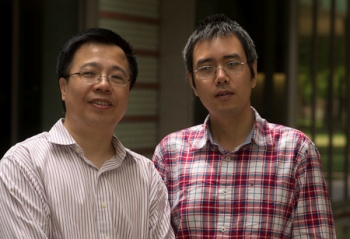Apr 5 2013
Rice University physicists on the hunt for the origins of high-temperature superconductivity have published new findings this week about a material that becomes “schizophrenic” — simultaneously exhibiting the characteristics of both a metallic conductor and an insulator.
 Qimiao Si (left) and Rong Yu
Qimiao Si (left) and Rong Yu
In a theoretical analysis this week in Physical Review Letters (PRL), Rice physicists Qimiao Si and Rong Yu offer an explanation for a strange series of observations described earlier this year by researchers at the Stanford Linear Accelerator Center in Menlo Park, Calif. In those experiments, physicists used X-rays to probe the behavior of electrons in superconducting materials made of potassium, iron and selenium. The material becomes superconducting at extremely cold temperatures, and the experiments revealed that at a slightly higher temperature, the material exhibited a “schizophrenic” electronic state in which some electrons in the iron atoms became frozen in place while electrons in neighboring orbitals continued to move.
“We have proposed a unified phase diagram for the alkaline iron selenides in which this schizophrenic phase connects between the lower-temperature, superconducting phase at one extreme and a higher-temperature insulating phase at the other,” said Si, Rice’s Harry C. and Olga K. Wiess Professor of Physics and Astronomy.
Flowing electrons power all the world’s energy grids, and a significant amount of power in those grids is lost to electrical resistance — a kind of electronic friction that occurs when electrons move through metallic wires. Superconducting materials, which were discovered more than a century ago, conduct electricity without any loss of power, but they only operate at extremely cold temperatures. Since the 1980s, scientists have discovered a number of new materials that become superconducting at temperatures that, while still cold, are above or close to the temperature of liquid nitrogen — an important threshold for engineering applications. The hope is that these “high-temperature” superconductors may one day be used to revolutionize power transmission and other technologies, but physicists have yet to develop a clear-cut understanding of how high-temperature superconductors work.
In classical superconductors, frictionless conduction is achieved when electrons pair up in a way that allows them to flow effortlessly, without the bumping and jostling that normally leads to electrical resistance. Electron pairing is uncommon because the rules of quantum mechanics typically make electrons loners. Under normal circumstances, electrons repel one another, and the mechanism that causes them to pair up in classical superconductors doesn’t account for their behavior in high-temperature superconductors.
Iron-based high-temperature superconductors were discovered in 2008. Si and collaborators, including UCLA physicist Elihu Abrahams, were among the first to propose a way in which superconductivity might arise in the iron-based materials due to a phenomenon known as “correlated electron” behavior. In correlated-electron systems, the behavior of electrons in a material can only be understood by viewing the electrons as a collective system rather than many individual objects.
Si and Yu’s new paper focuses on experiments with an alkaline iron selenide, one family of materials that is included in the larger class of iron-based superconductors. Prior experiments had found that alkaline iron selenides exhibited odd electronic behaviors at temperatures above the critical temperature in which they transition to the superconducting state.
In the PRL paper, Si and Yu describe a new electronic state, or phase, marked by electronic traffic congestion. They show that electrons in different quantum states, or orbitals, react differently to the bad traffic situation. In particular, the new phase is marked by electrons in selected orbitals becoming locked in a place — a phenomenon known as a Mott insulating state.
“In a theoretical model containing several orbitals, we identified an ‘orbital-selective Mott phase,’” said Yu, a postdoctoral research associate at Rice. “In this phase, electrons in some orbitals behave like an insulator, while those in the other orbitals act as a metal.”
Si and Yu said they saw the first hints of the new phase in a 2011 model they designed to study a different family of iron-based superconductors. In that model, the orbital-selective Mott phase ultimately proved to be unstable, so they were somewhat surprised when the phase appeared and proved stable in the model for the alkaline iron selenides.
“This is the first time anybody has identified an orbital-selective Mott phase in any model for the iron-based superconductors,” Yu said.
Si said characterizing the schizophrenic phase in the alkaline iron selenides provides more clues about the fundamental origins of superconductivity.
“Ultimately, our goal is to understand superconductivity and the conditions to optimize superconductivity,” Si said.
The premise is that this kind of bad traffic situation — the schizophrenic phase where electrons are in conflict as to whether they should freeze or move — is good for superconductivity.
“Our results provide evidence that electron correlations play a vital role in the superconductivity of the iron-based superconductors,” he said.
The research was funded by the National Science Foundation and the Robert A. Welch Foundation.